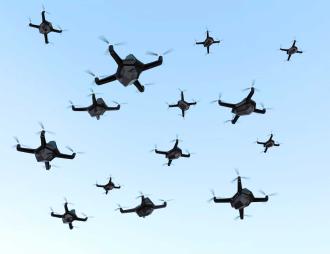Drones are transforming how we move over and through our urban landscape. Whether they’re delivering burritos, blood, or passengers, little aircraft will be most useful in dense urban areas, where they will have the most potential customers and destinations. But our current air traffic control system is too bulky and too limited to handle a world of drones zipping around cities at low altitudes. Fortunately, Raytheon has a possible solution: a new decentralized network of small radar scanners that can track many more objects at much lower altitudes.
The expression “flying under the radar” exists for a reason. Traditional radars are deliberately designed to ignore little stuff that could just be noise.
Under the Radar: Our current air traffic system uses huge, high-powered radar installations, built on towers to see over obstacles and maximize their range, to direct aircraft and avoid collisions. This works fine for the big commercial and military jets it was designed for, but the system can’t track flying objects at low altitudes. City landscapes are especially a nightmare for conventional radar: skyscrapers, hills, and valleys block radio waves, and building lots of big towers would be wasteful and expensive.
New Problems, New System: The defense contractor Raytheon thinks it has a solution for the brave new drone economy: skies with lots of small, short-range aircraft need lots of small, short-range radar sensors. The idea is to build a distributed network of low-power radar boxes that can cover a large area with varying geography. Raytheon says that these could be installed on existing cell towers or buildings, and they would provide a lot more detailed, precise, high-speed coverage than the big radar dishes that scan hundreds of miles.
Zeroing In: If you’ve ever seen radar dishes spinning (like in old-timey World War II newsreels), you’ve seen one limitation of the technology: it has to look away while it scans in the other direction. (You can also see this in the blip-blipping of targets on old-fashioned green radar scanners.) But there’s another type of system called “active electronically scanned array” that allows a computer to send a beam of radio waves directly at a target without physically moving the antenna or dish. Because the system never takes its “eye” off the target, it can track its location much more precisely and with much less lag time. It can also track a lot more targets than traditional radar, making it perfect for crowded airspace.
A high-resolution radar network could be used for a lot more than simply guiding burrito drones and Amazon deliveries to your doorstep.
Other Applications: As the chief engineer on the project told Wired, “You can also leverage it for microscale weather analysis, including 3-D wind information, and down to extremely localized tracking that could help future air vehicles as well as the general public.” The company’s recent tests showed that even a single unit without the whole network could track planes in a 20-mile radius and guide their landings with “surgical precision,” hinting that it could be used to further automate air travel. Raytheon says the system could be as cost-effective as the mega scanners, but, whether it’s GPS or a new radar network, we’re going to need to keep an eye on the skies, one way or another.
